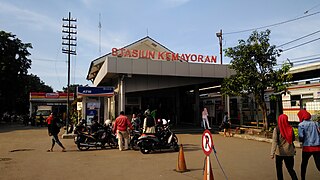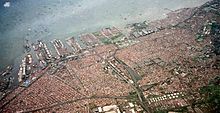
North Jakarta is one of the five administrative cities which form Special Capital Region of Jakarta, Indonesia. North Jakarta is not self-governed and does not have a city council, hence it is not classified as a proper municipality. It contains the entire coastal area within the Jakarta Special District. In North Jakarta, an area at the estuary of Ciliwung river was the main port for the kingdom of Tarumanegara, which later grew to become Jakarta. Many historic sites and artefacts of Jakarta can be found in North Jakarta. Both ports of Tanjung Priok and historic Sunda Kelapa are located in the city. The city, which covers an area of 139.99 km2, had 1,645,659 inhabitants at the 2010 census and 1,778,981 at the 2020 census. It has its administrative centre in Tanjung Priok.

Kemayoran is a district of Central Jakarta, Jakarta in Indonesia. It was best known for the former Kemayoran Airport. It has been transforming as a new Central business district. As of 2022, it consists of numerous four and five star hotels, restaurants, premium office towers, hospitals as well as shopping and entertainment centers. Kemayoran is also home to the Jakarta Fair, the largest and longest fair in Southeast Asia that attracts more than 4 million visitors annually.

Jatinegara is one of the districts (Kecamatan) of East Jakarta, Indonesia. The name also refers to the larger, historic area of the colonial town of Meester Cornelis. Established in the 17th century, Jatinegara is one of the oldest areas in Jakarta, and contains a number of buildings from the colonial period.
Jagakarsa is a district of South Jakarta, one of the administrative cities in Jakarta Indonesia. Jagakarsa is the southernmost district of South Jakarta Jagakarsa District is bounded by Ciliwung River to the east, Krukut River to the west, and Margasatwa-Sagu-Joe-T.B.Simatupang-Poltangan Road to the north, while the boundary marches with Depok city to the south.

Cilincing is a historic neighborhood of the coast of Jakarta, Indonesia. It is sandwiched between the Port of Tanjung Priok to the west and River Titram to the east. Cilincing has been for some decades one of the districts of North Jakarta which in turn encompasses as far as Marunda and some non-coastal hinterland.
Koja is a subdistrict of North Jakarta, Indonesia. It is known as the location of Kampung Tugu, a historic Portuguese-influenced neighborhood in North Jakarta.

Pademangan is a port-associated subdistrict of North Jakarta, Indonesia. It stretches from the Sunda Kelapa Harbor on the east to the western area of Tanjung Priok Harbor to the east. Geographically, it is a plain with an average height of 75 centimeters above the high tide sea level.

Jakarta is Indonesia's capital and largest city. Located on an estuary of the Ciliwung River, on the northwestern part of Java, the area has long sustained human settlement. Historical evidence from Jakarta dates back to the 4th century CE, when it was a Hindu settlement and port. The city has been sequentially claimed by the Indianized kingdom of Tarumanegara, the Hindu Kingdom of Sunda, the Muslim Sultanate of Banten, and by Dutch, Japanese and Indonesian administrations. The Dutch East Indies built up the area before it was taken during World War II by the Empire of Japan and finally became independent as part of Indonesia.

Port of Tanjung Priok is the busiest and most advanced Indonesian seaport, handling more than 50% of Indonesia's trans-shipment cargo traffic. The port is located at Tanjung Priok, North Jakarta, which is operated by Indonesian state owned PT Pelindo. The port loaded and unloaded 6.2 million, 6.92 million, and 7.8 million TEUs of cargo during 2016, 2017 and 2018 respectively, out of a total capacity of about 8 million TEUs. The container port ranked as 22nd busiest in the world by Lloyd's One Hundred Ports 2019.

Ancol is a coastal lowland area located to the east of Kota Tua Jakarta in northern Jakarta, in Indonesia. The coastal lowland stretched from Kota Tua Jakarta to the west and Tanjung Priok to the east. Today, Ancol contains the main beach resort of Jakarta. Taman Impian Jaya Ancol, the largest integrated tourism area in South East Asia, is located in Ancol.
The following is a timeline of the history of the city of Jakarta, Indonesia.

Tanjung Priuk Station (TPK), is a railway station in Tanjung Priok, Tanjung Priok, North Jakarta. It is located across the Tanjung Priok Port, which is the main port of Jakarta. This station is one of the oldest in Jakarta and the biggest station built during the Dutch East Indies era. It is included in the list of heritage buildings by the government of Jakarta.
Sunter is a neighborhood in North Jakarta, Indonesia. The neighborhood corresponds roughly with the Sunter Agung and Sunter Jaya administrative village of Tanjung Priok subdistrict of North Jakarta. Zip code of the area is 14350. The area is adjacent to Plumpang Semper in the north, Kemayoran in the west, Kelapa Gading in the east and Cempaka Mas in the south. The area probably named after Sunter River, which flows through the neighborhood. The area is a low terrain and prone to flooding during heavy rain.

Tandjong West was a particuliere land or private domain in modern-day Tanjung Barat, Jagakarsa, South Jakarta, Indonesia. The center of the domain was the eponymous Landhuis Tandjong West, an eighteenth-century Dutch colonial manor house.

Baru Timur River is a man-made canal flowing from Ci Liwung in Bogor Regency to Jakarta, Indonesia. It was one of two canals built in the 18th century under the order of the Governor-General Gustaaf Willem van Imhoff originally to transport agriculture harvest from Bogor to Batavia. Currently both canals, now known as Kali Baru Timur and Kali Baru Barat, are among the main rivers in Jakarta, and part of the Ciliwung Cisadane flood control project. Baru Timur River flows from Katulampa flood gate, built at the same time as the canal, along the major road Bogor Highway, passing Cimanggis, Depok, Cilangkap, until reaching Java Sea in Kali Besar, Tanjung Priok, North Jakarta.

The Baru Barat River is a man-made canal flowing from the Cisadane River in Bogor Regency to Jakarta, Indonesia. It was one of two canals built in the 18th century under the order of the Governor-General Gustaaf Willem van Imhoff, the other being the Baru Timur River. Both canals were originally built to transport agricultural harvests from Bogor to Batavia. They are among the main rivers in Jakarta, and part of the Ciliwung Cisadane flood control project. The Baru Barat River flows through the districts of Pancoran and Tebet in South Jakarta, and drains into the Banjir Kanal Barat.

Kemayoran Station (KMO) is a railway station located at South Gunung Sahari, Kemayoran, Central Jakarta, Indonesia. This station is located between Pasar Senen railway station in the south and Rajawali railway station in the north. The station is a stoppage for Jakarta metro commuter rail.

Tanjung Priok Dock of 4,000 Tons, was a floating dry dock built for Droogdok-Maatschappij Tandjong Priok in the 1890s.

Tanjung Priok Dock of 8,000 tons was a floating dry dock built for Droogdok-Maatschappij Tandjong Priok in the 1920s.
















